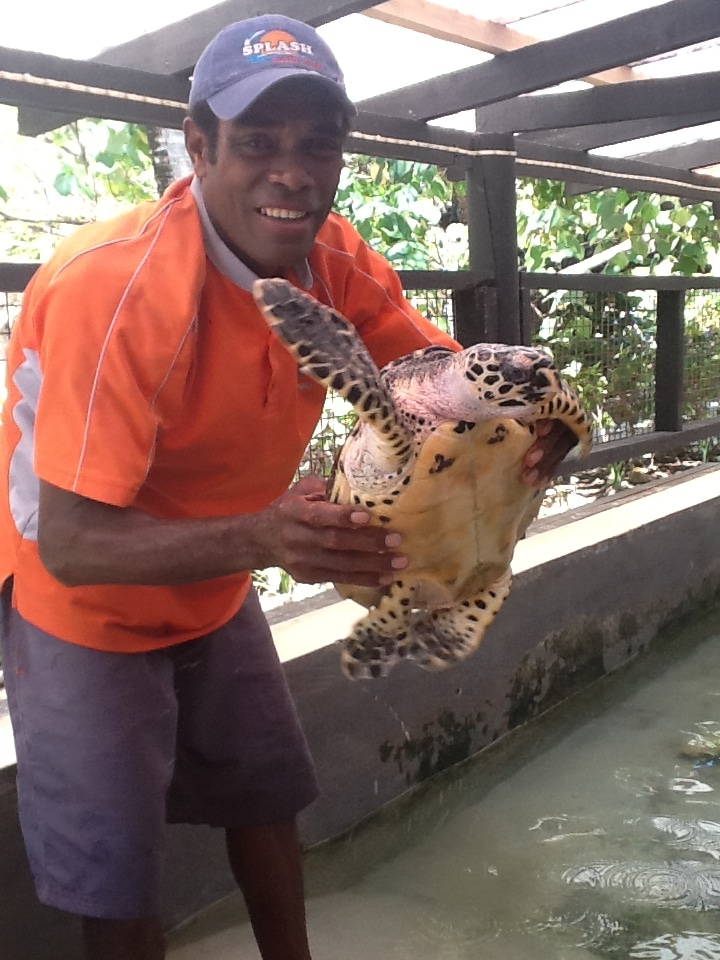“Swimming hundreds of miles across the vast ocean in search for familiar foraging grounds, only to encounter a tiger shark. Swimming frantically, escape is pronto to avoid becoming the tiger’s next meal .Thanks to the timely distraction from a big ray, a safe distance is gained and the tiger gave up chase. Mustering whatever little energy left, and in the hope of getting renewed energy, a floating sponge was hastily fed on. Panic rises as the possible repercussions from feeding greedily on that strange looking sponge slowly takes its toll towards unconsciousness and finally succumbing to the waves.”
This is how I imagine what the 18cm hawksbill turtle encountered before being rescued by the staff of Likuliku Lagoon Resort.
On Sunday morning the 27th of October, Mrs Marica Vakacola-MES Project Manager receives a call from Mrs Tulia Seru, Resort Manager at Likuliku Lagoon Resort, to report on a turtle that was found floating near the jetty. The turtle was barely moving at all.
Mrs Vakacola then liaised with Mana Island Resort for the transfer of the turtle to their rescue pond. Mana Island Resort has a turtle pond, which caters mostly for washed up and struggling hatchlings, and also juveniles and adults that are injured or found stranded on the beach.
The turtle from Likuliku, now called Likuliku Hawksbill was later transferred to Mana Island Resort, in the hope of recovery at the rescue pond.
With the need to determine the health status and save Likuliku Hawksbill, contact was made with Doctor Susana Piovano a turtle specialist at the University of the South Pacific. Dr Piovano was provided with details of the turtle’s condition, whereupon a conclusion drawn was the high possibility of the turtle ingesting a toxic substance.
Amongst other turtles in the rescue pond, who have suffered likely fates, Likuliku Hawksbill is given extra attention and nursed by the kind marine activities staff of Mana. While the other turtles dive or surface to capture food, the Likuliku Hawksbill remained at times, immobile during feeding time.
After three weeks at the pond, Likuliku Hawksbill was normally perched on a rock, with very little movements, and is hand fed. From time to time, he will leave the rock, but continue to float not far from it.
Guests that come to the pond to watch the turtles, show great concern for Likuliku Hawksbill, at most times thinking it is dead, only to be proved wrong by the very slightest of movement. On my last visit to the Mana turtle pond with the Malolo Kids Club, I noticed Likuliku Hawksbill moving his flippers slowly and silently through the water.
While writing this story, I received news that the Likuliku Hawksbill is no more.
What may seem like a mere turtle’s death, the facts surrounding it, not so mere! Must turtles continue to die due to our actions? How many more turtle deaths will serve us as a reminder to stop littering their homes?
That was some of the many questions that ran through my mind. The natural obstacles faced by young and adult sea turtles are staggering, but it is the increasing threats caused by humans that are driving them to extinction.
It is about time for us to be more considerate of the surrounding ecosystems and how livelihoods are affected if biodiversity is not protected. This has contributed to sustainable tourism in meeting the needs of today’s tourists, whilst at the same time conserve nature and enhancing opportunities for the future.


